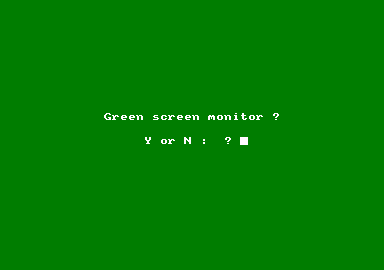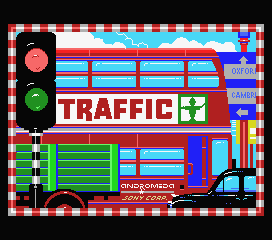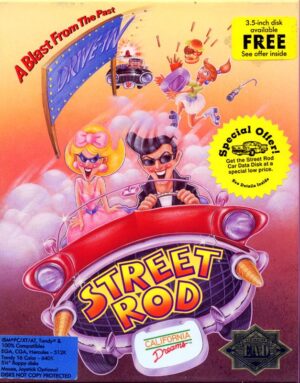Retro Replay Review
Gameplay
Traffic offers a deceptively simple premise that quickly evolves into an addictive challenge. As the traffic controller, your sole task is to switch traffic lights between red and green, directing cars, motorbikes, and buses through busy London intersections. The core loop revolves around clearing a preset number of vehicles before you can progress to the next level, making quick thinking and timing absolutely crucial.
(HEY YOU!! We hope you enjoy! We try not to run ads. So basically, this is a very expensive hobby running this site. Please consider joining us for updates, forums, and more. Network w/ us to make some cash or friends while retro gaming, and you can win some free retro games for posting. Okay, carry on 👍)
Each road entering the screen functions as both an opportunity and a potential bottleneck. Vehicles queue at the edge of the map, and if any queue exceeds five cars, the game ends. A warning beep warns you when a queue hits that limit, forcing you to glance at other roads and reevaluate your strategy. This dynamic keeps you on your toes and ensures that what begins as a calm flow of traffic can rapidly turn into a frantic scramble for control.
Levels become progressively harder by increasing the variety of vehicles, their entry rates, and the complexity of the street layout. While cars always stay on their side of the road and collisions are impossible, you’ll still encounter tense moments as you juggle multiple inflows of traffic. The lack of direct road hazards may seem to lower stakes, but real challenge emerges from the ever-present threat of gridlock if you fail to manage all directions evenly.
Graphics
Graphically, Traffic embraces a clean, minimalistic 2D top-down view that prioritizes clarity over visual flair. Roads are depicted with crisp lines, and each vehicle type—car, motorbike, or bus—has its own easily distinguishable icon. The game’s color palette relies heavily on traffic-standard reds, greens, and grays, immediately conveying the state of each light and road section.
Despite its simplicity, the art style contributes significantly to readability during hectic moments. Queued vehicles are represented by small number counters at off-screen exits, ensuring you never lose track of what’s building up beyond your field of view. Smooth transitions when lights change status, coupled with subtle motion cues on moving vehicles, enhance your situational awareness without overwhelming the screen.
On modest hardware, Traffic runs without hiccups or slowdowns, ensuring your split-second decisions aren’t hampered by technical issues. Ambient animations—such as pedestrian walk signals or occasional background traffic noise—add a pinch of life to the urban setting. Overall, the visuals expertly support the gameplay by keeping the interface intuitive, even as congestion intensifies.
Story
Traffic doesn’t follow a conventional narrative, but it frames its challenges within the bustling context of London’s iconic roadways. You aren’t a character embarking on a hero’s journey; instead, you’ve been handed the reins of the city’s control tower, responsible for maintaining order amidst the chaos. This role-playing element, though abstract, delivers a satisfying sense of purpose.
Each level’s layout reflects different parts of a metropolis—from narrow side streets to multi-lane highways—giving each stage its own flavor. Though the game refrains from scripted cutscenes or dialogue, you’ll quickly build an imagined backstory: perhaps you’re filling in for a veteran traffic warden, or testing a new AI system in a simulation lab. The lack of words leaves plenty of room for personal interpretation.
Subtle audio cues—like distant horns, the hum of engines, and the telltale ping when you clear a vehicle—serve as ambient storytelling devices. They conjure the atmosphere of a city that never sleeps, reinforcing the sense that your decisions carry real-world weight. Though minimal in narrative, Traffic’s world-building proves surprisingly effective for a game focused on numbers and timing.
Overall Experience
Traffic’s greatest strength lies in its pick-up-and-play accessibility combined with strategic depth. Beginners can grasp the basics within minutes, yet veterans will find themselves challenged by the higher-speed levels that demand foresight and multitasking prowess. The escalating difficulty curve is well-tuned, providing satisfying “aha” moments as you learn to anticipate incoming traffic waves.
Replay value comes from beating your own records—how many vehicles can you clear before a gridlock? While there’s no leaderboard baked in, the urge to improve is inherent. For players who appreciate low-pressure puzzlers and time-management titles, Traffic delivers exactly the right blend of calm planning and sudden urgency.
Whether you have five minutes to kill or are seeking a longer strategy session, Traffic slots neatly into both schedules. Its lightweight install size and simple mechanics mean you can dive straight in, and its addictive loop will have you flicking lights long after you intended to stop. For anyone curious about urban planning dynamics or just looking for a fresh take on puzzle games, Traffic is a clear, green signal worth following.
 Retro Replay Retro Replay gaming reviews, news, emulation, geek stuff and more!
Retro Replay Retro Replay gaming reviews, news, emulation, geek stuff and more!









Reviews
There are no reviews yet.